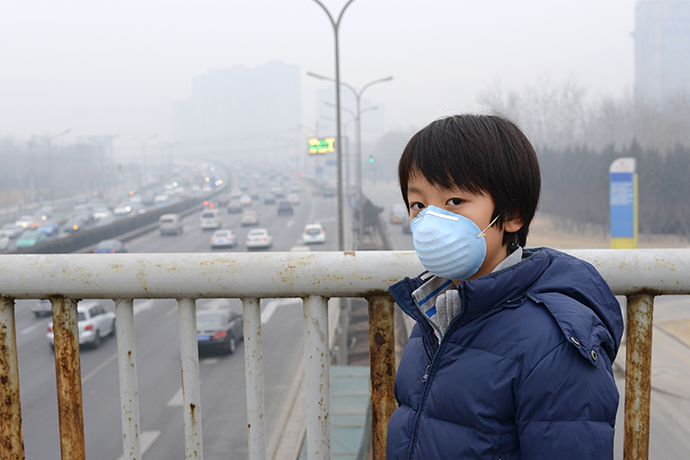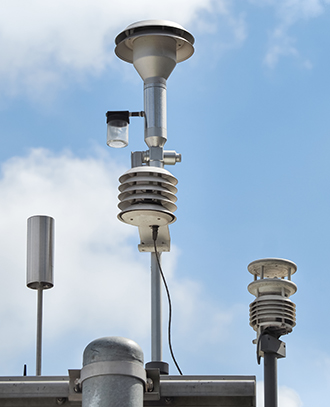

Air pollution kills millions of people every year. (Photo: tumeyes/iStock/Thinkstock)
A group of scientists writing in Nature have called for international action to improve air-quality forecasts worldwide to help reduce the death toll from air pollution.
In a comment paper published on 4 September, they propose improvements in the areas of monitoring, modelling, interpretation, dissemination and training.
Rajesh Kumar (NCAR), Guy Brasseur (NCAR), James H. Crawford (NASA) and Vincent-Henri Peuch, the Head of the Copernicus Atmosphere Monitoring Service (CAMS) implemented by ECMWF, cite dramatic figures: seven million people die every year from the effects of air pollution, with the vast majority of deaths in the developing world.
It may be less well known that air pollution also affects food production: crops currently lost in India due to damage caused by air pollution would feed almost 100 million people. This is because high levels of ozone and fine particles alter the plants’ physiology. They reduce their growth and thus yields.
And the list of known impacts keeps expanding. According to a recent study, exposure to air pollution has impacts on cognitive performance, which are especially marked for older people.
The authors of the Nature article call for action targeting especially the developing world, where information about air quality is currently sparse. They argue that there is much we can learn from efforts made over the last few decades in Europe and North America. While it has taken a long time, the effects are noticeable. There is a lot of experience of what works and what does not both to curb air pollution levels and to reduce people’s exposure to it.
Technological progress means that the exchange of information between scientists and decision-makers anywhere in the world is much easier today than in the past.

In some places air pollution can get so bad that some people wear masks to protect themselves, such as here in Beijing. (Photo: Hung_Chung_Chih/iStock/Thinkstock)
The paper acknowledges that the challenges are real. But it insists that there are opportunities to be grasped to improve monitoring, modelling/forecasting, the interpretation of data, the dissemination of outputs and training and education.
In the field of monitoring, the current and upcoming generation of satellites monitoring air pollution, including the Copernicus Sentinel-5 Precursor and the future Sentinel-4 instrument onboard Meteosat Third Generation satellites, are game changers. While ground-based networks are indispensable to monitor local levels in hot spots, satellite-based Earth observation will provide vital information on the background levels of air pollution. This can help cities and countries to develop their local networks in the most effective ways.
Advances in modelling and forecasting bring opportunities of their own. CAMS and a few other initiatives in the US and worldwide produce forecasts of atmospheric composition for the entire globe, albeit at fairly low resolution (40 km in the case of the CAMS forecasts run operationally at ECMWF).
Users of CAMS global forecasts, like the very successful smartphone applications Plume Labs and Breezometer, already demonstrate ways of downscaling information to the urban level, in particular by blending large-scale information with local observations when available. Reaching more people and enabling them to act at an individual level (by avoiding exposure, using public transport etc.) would bring sizeable benefits in itself.
The paper also calls for additional research into air-quality forecasts with longer lead times, going into the medium range and even seasonal timescales. This would widen the range of possible actions at national and local levels.

Ground-based monitoring networks provide vital information on local levels of air pollution. (Photo: VICHAILAO/iStock/Thinkstock)
Working on facilitating the interpretation of data and improving its dissemination is another area in which progress is possible. The advent of cloud computing unlocks many possibilities in countries with little technical or supercomputing infrastructure.
Last but not least, training and education is paramount to achieving progress worldwide. In the context of Copernicus, EUMETSAT and ECMWF will be running a Massive Open Online Course on ‘Monitoring Atmospheric Composition’ through the Iversity platform in the second half of October this year, and this can be used as a stepping stone for more initiatives.
The paper concludes by calling on the WMO, WHO, UNEP and FAO to facilitate the development of an international strategy to reduce the number of deaths caused by air pollution.
In addition to the online version, a PDF version of the Nature comment article is also available.
